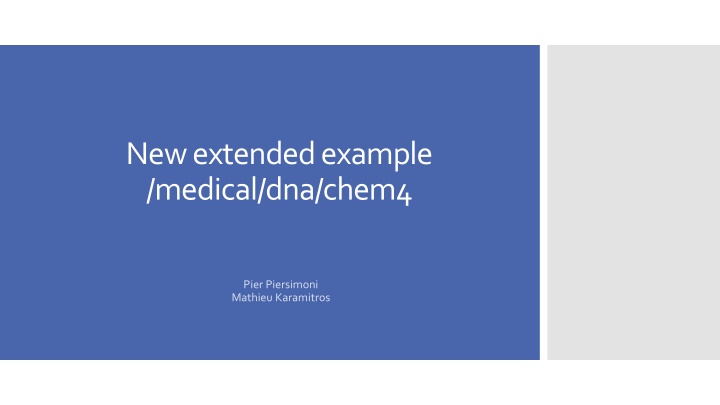
Chemical Species Evolution in Geant4 Simulations
Explore the dynamic changes in chemical species over time in Geant4 simulations for radiochemical yields and G-values. Learn about tools like G4MoleculeCounter, ScoreSpecies, and PrimaryKiller to record, score, and manage chemical species evolution efficiently.
Download Presentation

Please find below an Image/Link to download the presentation.
The content on the website is provided AS IS for your information and personal use only. It may not be sold, licensed, or shared on other websites without obtaining consent from the author. If you encounter any issues during the download, it is possible that the publisher has removed the file from their server.
You are allowed to download the files provided on this website for personal or commercial use, subject to the condition that they are used lawfully. All files are the property of their respective owners.
The content on the website is provided AS IS for your information and personal use only. It may not be sold, licensed, or shared on other websites without obtaining consent from the author.
E N D
Presentation Transcript
New extended example /medical/dna/chem4 Pier Piersimoni Mathieu Karamitros
Radiochemical yields or G-values Number of species over time for 100 eV of deposited energy ?(?) =????? 100 ?? Radiochemical yields ???? For a given species, irradiation condition, can be compared to experimental values Goal of chem4: record the G-values over time for each species
G4MoleculeCounter Where Component of Geant4 Role Records only the changes of chemical species over time Usage Run application Relevant classes
G4MoleculeCounter Where Component of Geant4 Role Records only the changes of chemical species over time ScoreSpecies Where Component of the application Run application Relevant classes Role 1. Scores the total energy deposited 2. Retrieves from G4MoleculeCounter the number of chemical species at given time (use SpeciesScorer::AddTimeToRecord) PrimaryKiller Where Component of the application Role Kills the primary track after it has lost more than a certain threshold UI /primaryKiller/eLoss600 eV
ScoreSpecies Where Component of the application Role Usage 1. Scores the total energy deposited 2. Retrieves from G4MoleculeCounter the number of chemical species at given time (use SpeciesScorer::AddTimeToRecord) Run application Relevant classes Time to record is hard coded can be removed using ScoreSpecies::ClearTimeToRecord()
G4MoleculeCounter Where Component of Geant4 Role Records only the changes of chemical species over time ScoreSpecies Where Component of the application Run application Relevant classes Role 1. Scores the total energy deposited 2. Retrieves from G4MoleculeCounter the number of chemical species at given time (use SpeciesScorer::AddTimeToRecord) PrimaryKiller Where Component of the application Role Kills the primary track after it has lost more than a certain threshold UI /primaryKiller/eLoss 600 eV
Usage of PrimaryKiller and ScoreSpecies Run application Relevant classes Default value Can be modified through UI /primaryKiller/eLoss 600 eV
Basic geometry: a cube Constructors: G4EmDNAPhysics & G4EmDNAChemistry Run application Usage Launch the application $ chem4 -mac beam.in -mt 6 An output file called Species.root is created
Launch the application $ plot Species.root Alternatively, launch plot without argument, a window will open to select the ROOT file Display G-values in respect to time Default unit is nanosecond Plot application Each tab = a different species Example Primary: 1 MeV electron, Energy loss limit: 600 eV, Only few events considered
